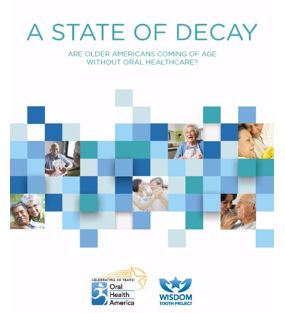CHICAGO, May 3 – Oral Health is an important part of overall health and well-being, but there are huge gaps in oral health particularly for older Americans. Because by the year 2030, it is expected that more than 19% of the U.S. population–almost one out of every five Americans–is expected to be 65 years or older, we can make a real difference by opening up a much broader conversation about the complex issues surrounding the oral health of older Americans as well as the goals and responsibilities of communities in providing support and access.
Oral Health America (OHA) has published a new report examining factors impacting the oral health of older Americans. A State of Decay, Vol. III is a state-by-state report of the oral health of its 65+ population and the success or failure of states to address those needs. It reveals that continued attention is needed to ensure that America’s increasing population of seniors age healthily and independently.
“Access to oral healthcare for older Americans is a matter of social justice, with those living in poverty suffering the most from the lack of publicly funded benefits needed to improve their oral and overall health,” said Dr. Caswell Evans, Associate Dean of Prevention and Public Health Sciences at the University of Illinois at Chicago School of Dentistry and member of Oral Health America's Board of Directors.
The report serves as a resource for states to address shortfalls in oral health status, dental benefits for low income adults and population-based prevention, all of which impact the oral health of older adults. It proposes concrete steps that can be taken to promote healthy aging and independence for this rapidly growing cohort of America’s population.
• Because early detection is key to early intervention, we need to support the Older Americans Act Reauthorization of 2016 which covers oral health screenings using health promotion funds
• Passing the RAISE Family Caregivers Act in the House of Representatives would improve education and training of caregivers on proper oral health maintenance
• One of the most critical challenges for seniors is paying for care, thus we need to advocate for financially viable publicly funded dental benefits through Medicaid and Medicare
• Community Water Fluoridation has been shown to positively impact oral health at a population level, thus we need to sustain implementation efforts
• To ensure that oral disease is prioritized along with other chronic diseases, we must include specific language to ensure inclusion of provisions for older adults in every state’s Oral Health Plan
• Finally, because information can drive policy and funding supports, we need to establish continuous surveillance of older adults’ oral health by requiring states to administer the Basic Screening Survey
A State of Decay, Vol. III gives a rating of “Poor,” “Fair,” “Good,” or “Excellent” based on state level data analyzing five variables impacting older adult oral health: Edentulism (loss of all teeth), Adult Medicaid Dental Benefits, Community Water Fluoridation, Basic Screening Surveys and State Oral Health Plans.
Two states, Minnesota and North Dakota emerged as models and are profiled for best practices in the report. Both earned a Composite Score of “Excellent” with a 100% and 96% rating respectively.
OHA ranked each of the 50 states based on the overall health status among the older adult population as measured by an overall state score referred to as a Composite Score. In order, the 10 states with the highest Composite Scores are Minnesota, North Dakota, Connecticut, Wisconsin, Rhode Island, Indiana, Florida, Virginia, Colorado and Michigan. The states with the lowest Composite Scores are Utah, Oklahoma, Texas, New Jersey, Montana, Mississippi, Wyoming, Hawaii, and Tennessee with Alabama’s score being the least favorable. The final evaluations for all 50 states revealed that 76% of states earned a Composite Score of 50% or less out of 100 with 22% earning a Composite Score of “Fair” and 54% earning a Composite Score of “Poor.” Ten states received a Composite Score of “Good.”
The top findings of this report that elicit further scrutiny and action are:
• Tooth loss remains a signal of suboptimal oral health. Eight states had strikingly high rates of edentulism, with West Virginia notably having an older adult population that is 33.6% edentate
• Fluoridated water presents an important opportunity for prevention. Five states (10%) still have 60% or more residents living in communities unprotected by fluoridated water. Hawaii (89.2%) and New Jersey (85.4%) have the highest rates of residents living without fluoridated water
• Improving oral health coverage would improve outcomes Sixteen percent of states (8 states) provide either no dental benefit or emergency coverage only through adult Medicaid dental benefits. Four states (8%) cover the maximum possible dental services in Medicaid
• We need strategic planning to address the oral health needs of older adults. Eighty-four percent (42 states) lack a State Oral Health Plan that mentions older adults, with 14 states lacking any type of State Oral Health Plan
• We need more data about the oral health condition of older adults. Forty-six percent (23 states) have never completed a Basic Screening Survey, a surveillance of the oral health conditions of seniors in community and long-term-care settings of older adults and have no plan to do so
“While many Americans face obstacles when it comes to oral health, older adults are at an increased risk due to challenges with accessing care,” said Dr. Dushanka Kleinman, a dentist and associate dean for research and academic affairs at the University of Maryland, School of Public Health. “We have to develop solutions at the practice and policy level to address the barriers older Americans experience.”
Links to the latest volume of A State of Decay and earlier editions can be viewed on toothwisdom.org.





